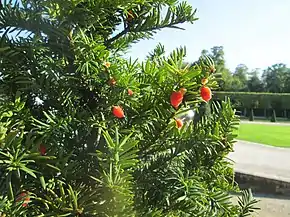زرنب
Arabic

زَرْنَب – Taxus baccata
Etymology
Unknown, the same as Classical Syriac ܙܪܢܒ (zarnVḇ), ܙܪܢܦ (zarnVp̄), ܙܪܢܘܒܬܐ (zarnūḇtā), ܙܪܢܘܦܬܐ (zarnūp̄tā), ܙܪܩܘܦܬܐ (zarqūp̄tā), seemingly containing ܙܪܥܐ (zarʿā, “seed”) often used in names of plants particularly if they provide spices.
Pronunciation
- IPA(key): /zar.nab/, /zar.nub/
Noun
زَرْنَب or زَرْنُب • (zarnab or zarnub) m
- (obsolete) mountain spignel (Libanotis pyrenaica) or sticky goosefoot (Dysphania botrys)
- 7th century CE, Ṣaḥīḥ Muslim, 44:135:
- زَوْجِي الرِّيحُ رِيحُ زَرْنَبٍ وَٱلْمَسُّ مَسُّ أَرْنَبٍ
- zawjī r-rīḥu rīḥu zarnabin wa-l-massu massu ʔarnabin
- My husband has the smell of mountain spignel, and the feel of a hare.
- a. 735, ذو الرمة [Ḏū ar-Rumma], poet identified in كتاب الأفعال of سعيد بن محمد المعافري القرطبي ثم السرقسطي، أبو عثمان، ويعرف بابن الحداد:
- وَإِنَّمَا أَنْتِ وَفُوكِ الْأَشْنَب … كَأَنَّمَا ذِرَّ عَلَيْهِ زَرْنَب
- wa-ʔinnamā ʔanti wa-fū-ki l-ʔašnab … kaʔannamā ḏirra ʕalay-hi zarnab
- Forsooth, you and your luscious mouth: it is as if cicely were strewn on it!
- (obsolete) coffee plum, East Indian plum (Flacourtia cataphracta syn. Flacourtia jangomas)
- yew (Taxus baccata)
- 1025, ابن سينا [Avicenna], القانون في الطب [Canon Medicinae]:
- زرنَب: الماهية: قضبان دقاق مستديرة الشكل ما بين غلظ المسلة إلى غلظ الأقلام سود إلى الصفرة ليس له كثير طعم ولا رائحة والقليلة من رائحته عطرية أترجة وقوته قوة جوزبوا ولكنه ألطف منه قليلاً وقد يقوم بدلاً عن الدارصيني فيما يقال.
الطبع: حار يابس في الثانية.
الأفعال: فيه قبض وتحليل للرياح.
أعضاء الرأس: يسعط بالماء ودهن الورد للصداع البارد.
أعضاء الغذاء: نافع للكبد والمعدة الباردتين منفعة بينة جداً.
أعضاء النفض: يعقل البطن فيما يقال.- (please add an English translation of this quotation)
Declension
| Singular | basic singular triptote | ||
|---|---|---|---|
| Indefinite | Definite | Construct | |
| Informal | زَرْنَب; زَرْنُب zarnab; zarnub |
الزَّرْنَب; الزَّرْنُب az-zarnab; az-zarnub |
زَرْنَب; زَرْنُب zarnab; zarnub |
| Nominative | زَرْنَبٌ; زَرْنُبٌ zarnabun; zarnubun |
الزَّرْنَبُ; الزَّرْنُبُ az-zarnabu; az-zarnubu |
زَرْنَبُ; زَرْنُبُ zarnabu; zarnubu |
| Accusative | زَرْنَبًا; زَرْنُبًا zarnaban; zarnuban |
الزَّرْنَبَ; الزَّرْنُبَ az-zarnaba; az-zarnuba |
زَرْنَبَ; زَرْنُبَ zarnaba; zarnuba |
| Genitive | زَرْنَبٍ; زَرْنُبٍ zarnabin; zarnubin |
الزَّرْنَبِ; الزَّرْنُبِ az-zarnabi; az-zarnubi |
زَرْنَبِ; زَرْنُبِ zarnabi; zarnubi |
Descendants
- → Middle Armenian: զառնաբ (zaṙnab)
References
- “zrnwph”, in The Comprehensive Aramaic Lexicon Project, Cincinnati: Hebrew Union College, 1986–
- “zrˁ”, in The Comprehensive Aramaic Lexicon Project, Cincinnati: Hebrew Union College, 1986–
- “nwb”, in The Comprehensive Aramaic Lexicon Project, Cincinnati: Hebrew Union College, 1986–
- “qwp3”, in The Comprehensive Aramaic Lexicon Project, Cincinnati: Hebrew Union College, 1986–
- Corriente, F. (1997) A Dictionary of Andalusi Arabic (Handbook of Oriental Studies. Section 1 The Near and Middle East; 29), Leiden, New York, Köln: Brill, →ISBN, →LCCN, page 229
- Corriente, Federico, Pereira, Christophe, Vicente, Angeles, editors (2017), Dictionnaire du faisceau dialectal arabe andalou. Perspectives phraséologiques et étymologiques (in French), Berlin: De Gruyter, →ISBN, page 583
- Dozy, Reinhart Pieter Anne (1881) “زرنب”, in Supplément aux dictionnaires arabes (in French), volume 1, Leiden: E. J. Brill, page 589
- Freytag, Georg (1833) “زرنب”, in Lexicon arabico-latinum praesertim ex Djeuharii Firuzabadiique et aliorum Arabum operibus adhibitis Golii quoque et aliorum libris confectum (in Latin), volume 2, Halle: C. A. Schwetschke, page 235
- Karbstein, Andreas (2002) Die Namen der Heilmittel nach Buchstaben: Edition eines arabisch-romanischen Glossars aus dem frühen 17. Jahrhundert (Kölner Romanistische Arbeiten – Neue Folge; Heft 81) (in German), Geneva: Librairie Droz, pages 121–122
- Abu Rejxan Beruni (1973) Izbrannyje proizvedenija. Tom 4. Farmakognozija v medicine (Kitab as-Sajdana fi-tibb) [Selected Works. Volume 4. Book on the Pharmacopoeia of Medicine] (in Russian), research, translation, notes and indexes by U. I. Karimov, Tashkent: Uzbek SSR Academy Press, pages 492–493 Nr. 493
- Löw, Immanuel (1928) Die Flora der Juden (in German), volume 1, Wien und Leipzig: R. Löwit, pages 364–366
- Maimonides (1940) Max Meyerhof, editor, Sharḥ asmāʾ al-ʿuqqār : L'explication des noms de drogues : Un glossaire de matière médicale de Maïmonide (in French), Cairo: Impr. de l'Institut française d'archéologie orientale, page 67 Nr. 137
- Vullers, Johann August (1856–1864) “زرنب”, in Lexicon Persico-Latinum etymologicum cum linguis maxime cognatis Sanscrita et Zendica et Pehlevica comparatum, e lexicis persice scriptis Borhâni Qâtiu, Haft Qulzum et Bahâri agam et persico-turcico Farhangi-Shuûrî confectum, adhibitis etiam Castelli, Meninski, Richardson et aliorum operibus et auctoritate scriptorum Persicorum adauctum (in Latin), volume II, Gießen: J. Ricker, page 130a
This article is issued from Wiktionary. The text is licensed under Creative Commons - Attribution - Sharealike. Additional terms may apply for the media files.